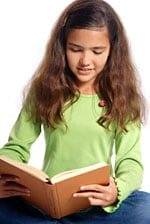Free shipping on USA orders over $129!

Today is grocery day at our house. And you can be sure that after last time’s post, I’m going to be picky in the produce section.
But you know, bringing home that delightful food is just the first step. It’s what you do with it after you get it home that counts.
If I set all that delicious fruit on the countertop, arrange it nicely, and make a point of looking at it every day, it will profit me nothing. In fact, it will turn into a wasteful distraction.
It’s the same with books. Selecting good living books is just the beginning. (We talked about selecting living books last time.) Once you get them home, what do you do with them?
Charlotte Mason gave us clear instructions on how to best use living books.
- Enjoy the book yourself and share your enthusiasm.
There is something stimulating about enjoying a good book together.
- Do not interpose yourself between the book and the child.
Allow the child to get directly in touch with the author’s mind by reading her words. Let his form his own relation.
- Do not ask direct questions on the content.
“Questions are an impertinence which we all resent” (Vol. 6, p. 260). When we ask direct questions, we are telling the child what his relation should be.
- Require the child to narrate a paragraph or chapter after a single attentive reading.
Ask the child to tell you all she recalls, rather than quizzing her to find out what she doesn’t remember. Let her tell you what relation she is forming. And keep in mind that a single reading is crucial to developing the habit of attention.
- Let the child labor mentally to draw out the ideas that he forms relations with.
Charlotte was adamant that the child must do the work. It’s easy to get lazy and wait for someone else (the parent or teacher) to spoon-feed information. But a truly educated person has learned how to feed himself, how to “self educate.” And if the book is living, that mental labor will not be tedious.
- Require older children to read for themselves.
As much as we moms like to snuggle on the couch and read aloud to our children, Charlotte reminded us that children who can read on about a fourth-grade or fifth-grade level should start reading some of their books on their own. They need to see the words and punctuation as they read in order to add to their mental storehouses for spelling, grammar, and composition.
Good living books used in this way will help our children form those important relations that make up true education. They will develop those necessary personal connections with ideas and people. They will know, as one knows a good friend.
Charlotte also said that we should use things to help our children form relations. Next time we’ll talk about which things she recommended.

Thank you. I LOVE receiving your emails and reading from your sight. I thank you for this article, because #6 really hit me. I have a 6-year old who reads like a 4th grader. She is VERY bright. However, I always feel guilty whenever I have her read anything on her own. We still do *some* reading together, but with have three other small children (3 and under) it is very difficult to ALWAYS read EVERYTHING aloud to her. Now, knowing that this will be good for spelling and grammar, which is also a small part of our school week, I know it is GOOD for her to read on her own in ADDITION to having SOME read aloud time. Also, I have her read aloud to me so I can help correct any mistakes (word pronunciation and pauses at commas and periods, etc.)
It’s my little ones who need to be read aloud to. (This is another place we “employ” our daughter’s read aloud capabilities–reading to her younger brothers’ and sister).
Anyways, thank you so much for this! You and Ambleside Online are the BEST Charlotte Mason resources I have ever come across. I could learn all I need to know between the two of your sites. THANK YOU!
We love living books. This blog post is excellent. I’m looking for a living book about the depression era for grade school children. Any ideas?
Jenn
Have you seen Children of the Great Depression or, for younger children, Rocks in His Head?
Quick question on #4. I am new to CM, but have read several times about just having a single reading of a book. I’m not sure I completely understand it. Does it mean you only read the book once ever OR you only read it once for the purpose of narration? My kids (almost 5 and 3) find a book they love and want to read it over and over. Is that okay or would I somehow be working against the habit of attention? Thanks in advance!
Only once for the purpose of narration, you’re correct. Please feel free to read a favorite over and over.